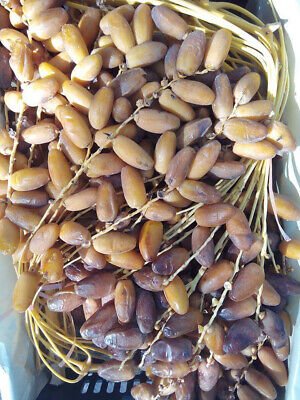
Kurma Bertangkai and the Enduring Legacy of Dates
The world of dates offers a captivating journey through taste, tradition, and history. Among the many intriguing varieties, Kurma Bertangkai, also known as Deglet Nour dates, holds a special place, particularly in countries like Tunisia and Malaysia. But how long have these delightful treats been gracing our palates? This blog post delves into the captivating story of these dates and embarks on a historical expedition to uncover the remarkable longevity of date cultivation.
Unveiling the Allure of Kurma Bertangkai
Kurma Bertangkai, meaning “stalk dates” in Arabic, refers to a specific variety of dates grown in Tunisia. These dates are characterized by their:
- Distinctive Appearance: Unlike some other date varieties, Kurma Bertangkai are typically harvested while still attached to the stalk, hence their name. This unique presentation adds a rustic charm and visual appeal to these dates.
- Amber Hue: Their skin boasts a stunning amber hue, often flecked with golden highlights.
- Sweet and Succulent Flesh: Beneath the beautiful skin lies a soft, succulent flesh that offers a delightful balance of sweetness and a subtle caramel-like flavor.
These dates are not only revered for their taste and appearance, but they also possess a rich nutritional profile, being a good source of fiber, potassium, and magnesium.
A Journey Through Time: Exploring the Enduring Legacy of Date Cultivation
The story of date cultivation stretches back millennia, weaving a fascinating tapestry across various civilizations. Here’s a glimpse into the remarkable longevity of dates:
1. Early Traces: Archaeological evidence suggests that date palm cultivation dates back to a staggering 7000 BC in Mesopotamia, the region between the Tigris and Euphrates rivers. This places the initial cultivation of dates thousands of years before the rise of major ancient civilizations.
2. An Integral Part of Ancient Societies: Dates played a significant role in the lives of ancient civilizations like the Egyptians, Babylonians, and Assyrians. They were considered a valuable source of food, and their significance extended to religious and cultural practices. Images of date palms and depictions of their harvest can be found in ancient artwork and historical records.
3. Continuous Cultivation and Spread: Over the centuries, date cultivation spread across various regions, including North Africa, the Arabian Peninsula, and the Mediterranean. Each region developed unique cultivation techniques and fostered distinct date varieties, including Kurma Bertangkai in Tunisia. This continuous cultivation and diversification ensured the continued presence of dates throughout history.
4. Modern Practices and Enduring Appeal: Today, date palm cultivation remains a vital part of the agricultural landscape in many regions, with countries like Egypt, Saudi Arabia, and Iran being major producers. Modern advancements in irrigation, pollination, and pest control have further optimized date cultivation, ensuring the continued availability of these delicious and nutritious fruits for future generations.
Conclusion: A Sweet Legacy for the Future
The story of Kurma Bertangkai and the date fruit, in general, is an inspiring testament to their enduring appeal and historical significance. From their ancient origins to their contemporary presence in diverse cultures and culinary traditions, dates continue to captivate our taste buds and enrich our understanding of the world’s agricultural heritage.
Key Highlights:
- Kurma Bertangkai, meaning “stalk dates,” is a unique date variety from Tunisia.
- Dates boast a history of cultivation dating back to a remarkable 7000 BC.
- Ancient civilizations like the Egyptians and Babylonians considered dates a valuable resource.
- Date cultivation has continued and diversified across various regions, with modern practices ensuring their future availability.